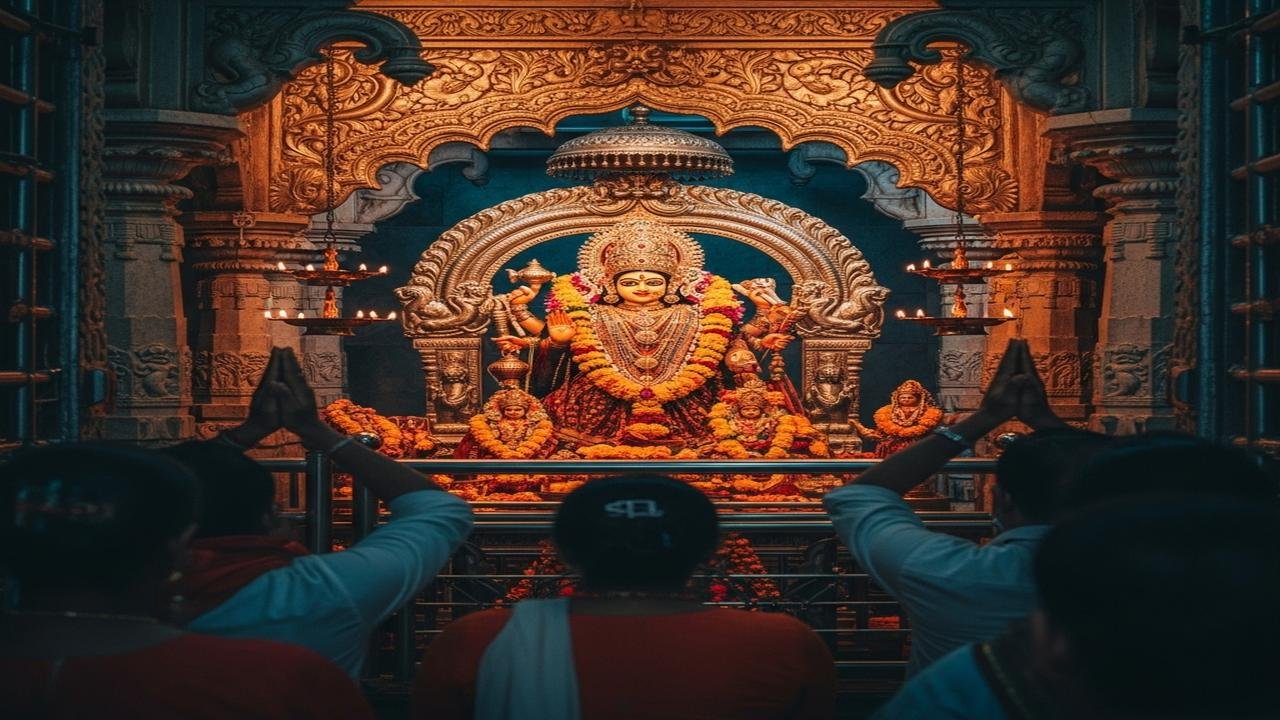Garbhagriha The Temple Womb House And Inner Sanctum

What is the Garbhagriha?
The word garbhagriha — literally “womb-house” — names the innermost chamber of a Hindu temple where the principal image or symbol of the deity is installed. In English architectural terms it is often called the “cella” or sanctum. It is typically a small, windowless room placed at the centre of the temple plan and aligned with the temple’s vertical axis.
Functional reasons: practical and ritual
The garbhagriha serves several interlocking practical and ritual purposes:
- Protecting the image: A durable, enclosed chamber shields the deity’s murti (icon) or aniconic symbol (for example, a śiva-linga or a saligrama) from weather, dust and theft.
- Site of consecration: Many Agama and temple ritual manuals describe the rite of prāṇa-pratiṣṭhā — installation of life-force — which is performed at the sanctum’s core. After consecration the image is treated as a living presence, and the garbhagriha is the proper locus of that presence.
- Controlled ritual access: The inner room allows priests to perform daily rites (puja, abhisheka) according to liturgical requirements without distraction. It also establishes ritual boundaries between the inner sacred and the public outer spaces.
- Acoustics and darkness: Enclosure helps concentrate chant, bells and the sound of mantras. Dim light and focused lighting on the image aid visual concentration and a sense of transcendence during darśana (seeing the deity).
Symbolic and cosmological meanings
Beyond the practical, the garbhagriha carries rich symbolic significance that architects and ritualists have emphasised across centuries:
- Womb and heart: As the word suggests, the sanctum is likened to a womb or a heart — the temple’s creative centre. In many texts the deity is conceived as residing in the “womb” of the temple, mirroring the cosmic process of creation and birth.
- Microcosm and axis mundi: Temple plans are often based on a mandala (sacred square grid). The central cell of this grid is the garbhagriha, representing Mount Meru or the cosmic centre. The vertical axis from foundation rock through the sanctum to the pinnacle (shikhara/vimana) symbolises a connection between earth and heavens.
- Inner journey: Moving from the outer gate through courtyards, pillared halls and finally into the sanctum stages an inward spiritual progression. For many devotees, approaching the garbhagriha is a symbolic movement from multiplicity to unity, from outer identity to inner presence.
Textual and architectural foundations
Medieval temple treatises and regional architectural manuals—collectively referred to as vastu-śāstras and the Agama literature—shape the concept and siting of the garbhagriha. These texts provide rules about proportions, orientation and the ritual essentials of consecration. Classical examples of architectural practice appear from the early medieval period onwards (roughly 6th–10th centuries CE) when stone temples with distinct sancta became widespread across India, though simpler shrines and household altars predate and coexist with this tradition.
Variations by tradition and region
There is no single model. Different denominations and regions adapt the garbhagriha to theological and ritual needs:
- Śaiva temples: Many house a lingam in a compact sanctum; inner garbha treatments and ritual secrecy vary between monastic and local temple types.
- Vaiṣṇava temples: The murti is often a fully formed icon richly dressed and ornamented; some Vaishnava traditions have more accessible sancta for communal darśana, others maintain strict priestly control.
- Śākta shrines: Depending on the image (stone, metal, yantra), the sanctum’s interior will be adapted to special rites; in some forms of tantric worship, the sanctum may be small and deliberately austere or secretive.
- Regional architecture: In Orissan, Dravidian and Nagara styles the garbhagriha’s relationship to the tower above varies (vimana vs shikhara), and temple complexes can contain many inner sancta (e.g., Srirangam, Kumbhakonam).
Social and performative functions
The garbhagriha also organises social relations and festival dynamics:
- Priestly roles: Restriction of access to the sanctum defines priestly duties and ritual authority, while allowing lay devotees to participate through darśana and prasāda.
- Festival movement: During utsava (festival) the principal image is often carried out on procession in an elaborately decorated chariot or palanquin. This movement from inner to outer re-enacts the deity’s involvement with the community.
- Conservation and continuity: Small, secure sancta preserve ancient images and ritual objects across generations, making the temple a repository of cultural memory.
Architectural effects aimed at devotion
Design choices inside the garbhagriha—compact dimensions, low entrance thresholds, thick walls, focused lighting—are not accidental. They create a sensory environment that encourages reverence, inward attention and the experience of presence. For many devotees, this concentrated setting intensifies devotion in a way that open, public spaces cannot.
Diversity, change and contemporary practice
Temples are living institutions. Some modern temples reinterpret the sanctum: glass-fronted shrines, larger accessible sancta, or public sanctum floors that broaden access. Conversely, many tradition-minded temples retain strict sanctum protocols. Interpretations of the garbhagriha’s meaning continue to coexist—ritualists emphasise its role as the deity’s domicile; philosophers read it as a symbol of inner self-realisation; historians track its evolution as an architectural form.
Summary: why a garbhagriha?
- Practical: protection, consecration and focused ritual work.
- Symbolic: womb, heart, cosmic centre and inner journey.
- Architectural: central cell in the mandala and axis alignment to the tower above.
- Social: organises priestly roles, festival movement and communal memory.
Whether experienced as a theological reality, an architectural necessity, or a poetic symbol, the garbhagriha remains the axis around which the temple’s spiritual, social and aesthetic life turns. Different schools and regions give it different emphases, but across traditions it functions as the privileged place where the human and divine meet.
